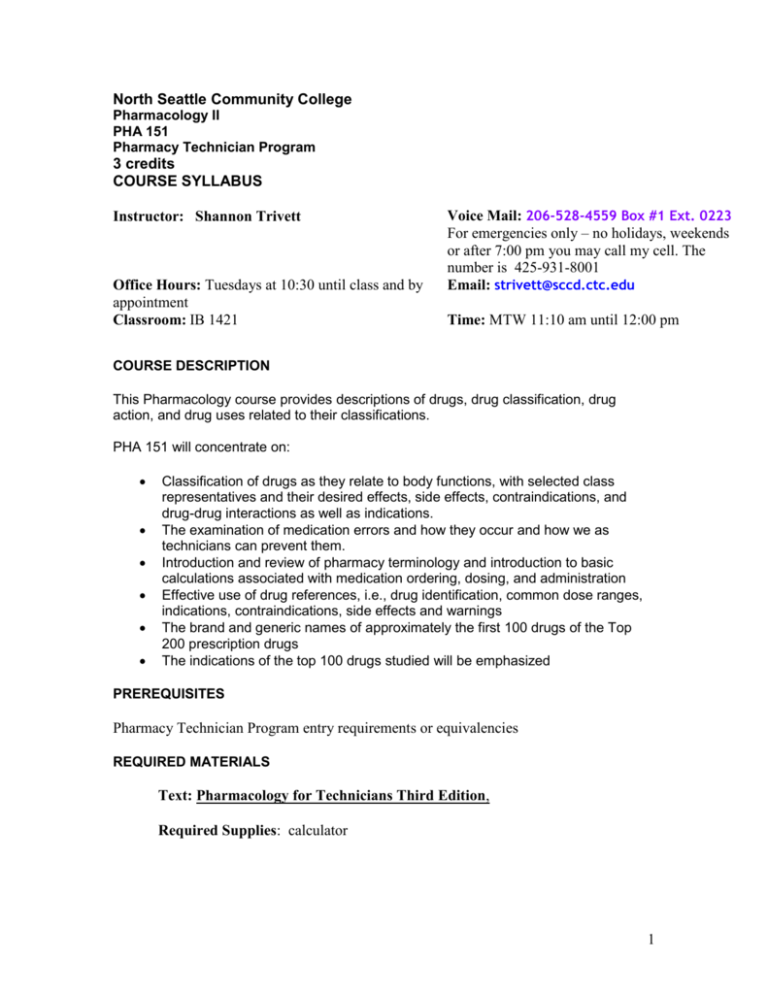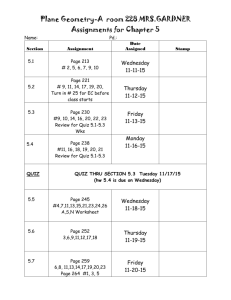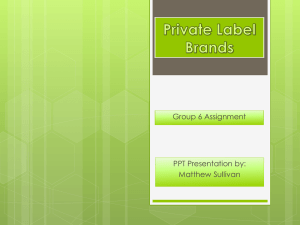course syllabus
advertisement

North Seattle Community College Pharmacology II PHA 151 Pharmacy Technician Program 3 credits COURSE SYLLABUS Instructor: Shannon Trivett Office Hours: Tuesdays at 10:30 until class and by appointment Classroom: IB 1421 Voice Mail: 206-528-4559 Box #1 Ext. 0223 For emergencies only – no holidays, weekends or after 7:00 pm you may call my cell. The number is 425-931-8001 Email: strivett@sccd.ctc.edu Time: MTW 11:10 am until 12:00 pm COURSE DESCRIPTION This Pharmacology course provides descriptions of drugs, drug classification, drug action, and drug uses related to their classifications. PHA 151 will concentrate on: Classification of drugs as they relate to body functions, with selected class representatives and their desired effects, side effects, contraindications, and drug-drug interactions as well as indications. The examination of medication errors and how they occur and how we as technicians can prevent them. Introduction and review of pharmacy terminology and introduction to basic calculations associated with medication ordering, dosing, and administration Effective use of drug references, i.e., drug identification, common dose ranges, indications, contraindications, side effects and warnings The brand and generic names of approximately the first 100 drugs of the Top 200 prescription drugs The indications of the top 100 drugs studied will be emphasized PREREQUISITES Pharmacy Technician Program entry requirements or equivalencies REQUIRED MATERIALS Text: Pharmacology for Technicians Third Edition, Required Supplies: calculator 1 OUTCOMES Upon successful completion of this 5-credit course, the student will be able to: Interpret and demonstrate the use of common abbreviations and calculations associated with the ordering and administration of medications Incorporate the use of resource materials and manuals to identify a drug and its uses, common dose ranges and dosage form, side effects, and contraindications and warnings Pronounce, define and identify drug classifications and names Provide an example of a representative drug when given a specific drug class Identify common medications related to body systems, their classifications, desired effects and side effects, drug-drug interactions, and contraindications. Provide brand and generic names for the top 100 (out of the top 200) prescription drugs and be able to discuss selected information about these drugs. Recognition of sound-alike drugs and problem identification within prescriptions, as well as knowing what the medications are used for and be able to prevent medication errors from occurring as a result of this knowledge. ACTIVITIES TO ACHIEVE OUTCOMES Study and reading of appropriate chapters in the pharmacology text as well as memorizing brand and generic names as well as terminology on the handouts is highly advisable. To do well in this class it is advisable you study at least two hours a night. Flashcards (colored) with drug names – brand and generic, side effects, warning labels and drug class are highly recommended for studying. Survey of available drug information resources, including the Internet and drug information resources common to the practice of pharmacy and pharmacology (e.g. Facts and Comparisons, USP Drug Information, Micromedex, Medline, MedIndex, American Hospital Formulary Service Drug Information, Handbook of Nonprescription Drugs, Drug Interactions, Applied Therapeutics, Pharmacological Basis of Therapeutics, Remington’s Pharmaceutical Sciences) Focus on the top 200 plus drugs of the handout in terms of class, properties, drug-drug interactions, precautions and warnings, and common indications for these drugs is essential. Assignments will include referencing drugs and drug properties with the appropriate resources as they apply to real life applications. Assessments in the form of quizzes, assignments and exams will be given and may include True/False questions, multiple choice questions, short answers, or essay questions. The understanding of the pharmacological process will be expressed and evaluated via an oral presentation and written project. Oral practice and scenarios will take place in class as well emphasizing real life customer service and technician roles. 2 GRADING The student's grade will be based upon the student's completion of assignments, projects, presentations, tests and quizzes. Course grade is based on percentage attained of total possible points. A GPA of 1.8 (75%) is required to receive a certificate of completion. Assessment Criteria. Grading is by a decimal scale and will be based on the average of the following activities: Quizzes/exams/assignments - 90% accordingly Indication/Drug/Mechanism of Action and therapy project paper - 5% Oral presentation of project - 5% NOTE 1: All assignments received 1 week after the due date will lose 50% of the given grade and after 1 week the score will be 0. NOTE 2: In the event of your absence of a test or quiz, I must be notified before class begins with a valid reason. If I am not notified the score will be a zero and I take this very seriously. It is professional and courteous to let me know if you won’t be able to take an exam, just as this will matter in your career. Again, I must be notified ahead of time. I understand things happen, just let me know in a timely matter so I can respond accordingly. Note 3: I expect punctuality and professionalism to be a part of this class, as ultimately we are preparing you for a job. SCHOLASTIC HONESTY For this class, any incidence of cheating or other dishonest activity will result in no credit for the test or assignment with no make-up allowed, possible disciplinary action by the college, and may jeopardize your status in your degree or certificate program. Cheating is the unauthorized giving OR receiving of information regarding testing or other material. Both the individual providing the information and the individual receiving information are cheating. Students will conduct themselves in accordance with the Student Code of Conduct, as specified in the constitution of NSCC. 3 SUGGESTED COURSE SCHEDULE: (Note: A study of the Top 200 Prescription Drugs will be ongoing throughout this quarter – work sheets and study guides will be provided Week 1 (April 3, 4 & 5): Intro and Chapter 4 - Antibiotics Week 2: (April 10, 11 & 12): Chapter 4 until finished. Start Chapter 5 Week 3: (April 17, 18 & 19): Continue Chapter 5 and start Chapter 9 - Asthma ~Brand/Generic Quiz 1 on Chapter 4, Wednesday Weeks 4: (April 24, 25 & 26): Finish Chapter 9, start Chapter 10 – GI drugs ~Brand/Generic Quiz 2 on Chapter 5, Wednesday ~Homework assignment due on Wednesday Week 5: (May 1, 2 & 3): Start Chapter 11 – Urinary System ~Brand/Generic Quiz 3 on Chapter 9 on Wednesday Week 6: (May 8, 9 & 10): ~Midterm on Wednesday – Chapters 4, 5, 9 & 10. Week 7: (May 16, 17 & May 18): Start Chapter 12 – Cardiovascular Drugs ~Brand/Generic Quiz 4 on Chapter 10 ~Homework assignment due on the 18th – Wednesday Week 8: (May 22 & 24): Chapter 12 continued – Hypertension ~Brand/Generic Quiz 5 on Chapter 11 Week 9: (No class May 29, but class on May 30th & May 31st) Chapter 12 – Anticoagulants, Antiplatelets and Hyperlipidemia ~Brand/Generic Quiz 6 on Chapter 12 – Hypertension Wednesday Week 10: (June 5, 6 & 7): Chapter 13: NSAIDS and DMARDS (Disease Modifying Antirheumatic Drugs) ~Brand/Generic Quiz 7 on Chapter 12 – Antiplatelets, anticoagulants and Hyperlipidemia on Wednesday ~Project Reports due on Tuesday the 6th. Week 11: Final – Tuesday June 13th - 11:00 until 1:00 pm on Chapters 11, 12 and 13 4





